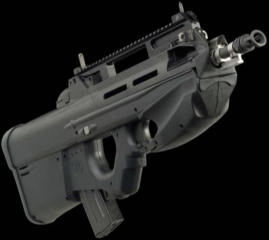

 The Accurate Reloading Forums
The Accurate Reloading Forums  THE ACCURATE RELOADING.COM FORUMS
THE ACCURATE RELOADING.COM FORUMS  Rifles
Rifles  Modern Military Rifles
Modern Military Rifles  AR blow up- what happened?
AR blow up- what happened?Go  | New  | Find  | Notify  | Tools  | Reply  |  |
| one of us |
A buddy of my son had an AR rifle blow up at the range today. Good news is nobody was injured. I do not know a lot of the details but here is what I do know: It's a proven rifle that he's not had problems with. He was using remanufactured ammunition from a large nationwide source. He had fired about a dozen shots from a magazine when the event occurred. Before you ask I do not know very many other details but the following pics tell a lot. Was it case failure? Or did the rifle fire when not in battery? P.S. Yes, total case separation and the remainder of the cartridge case is in the chamber. Pic #1 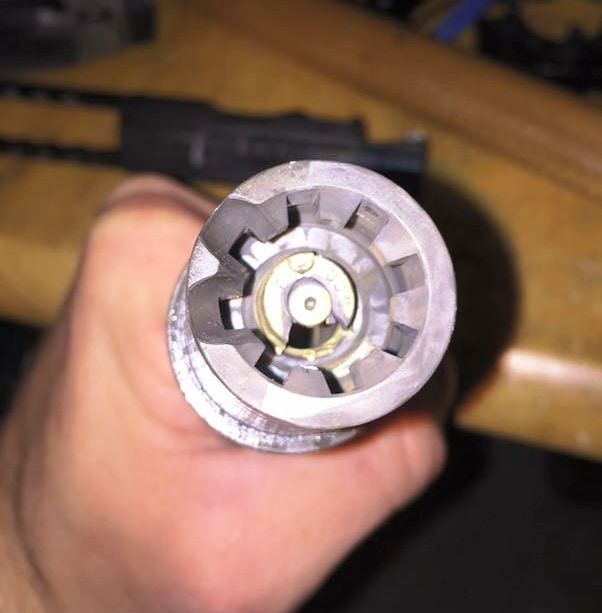 Pic #2 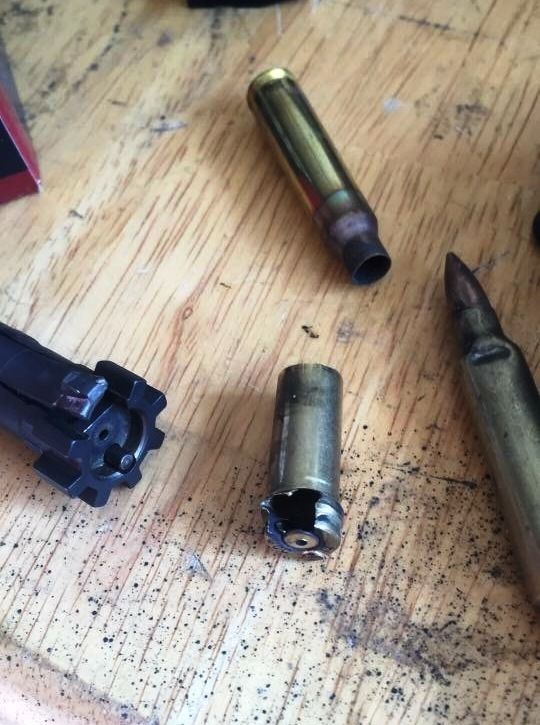 Pic 3 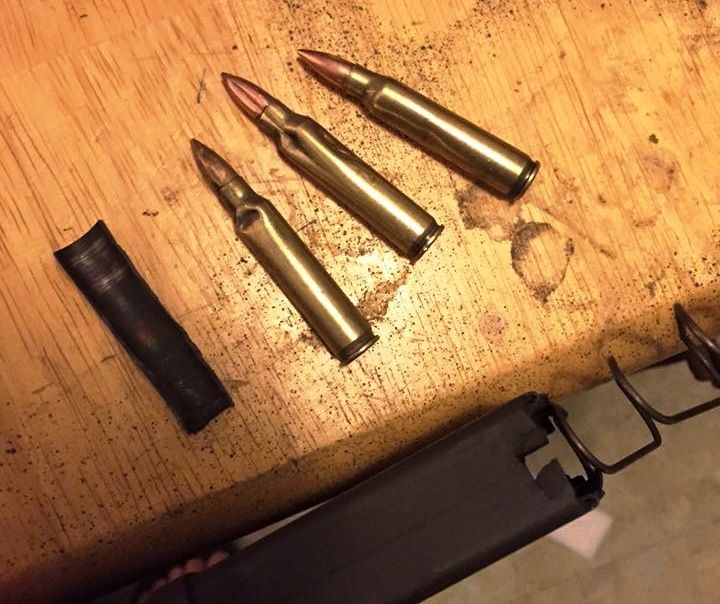 Pic 4 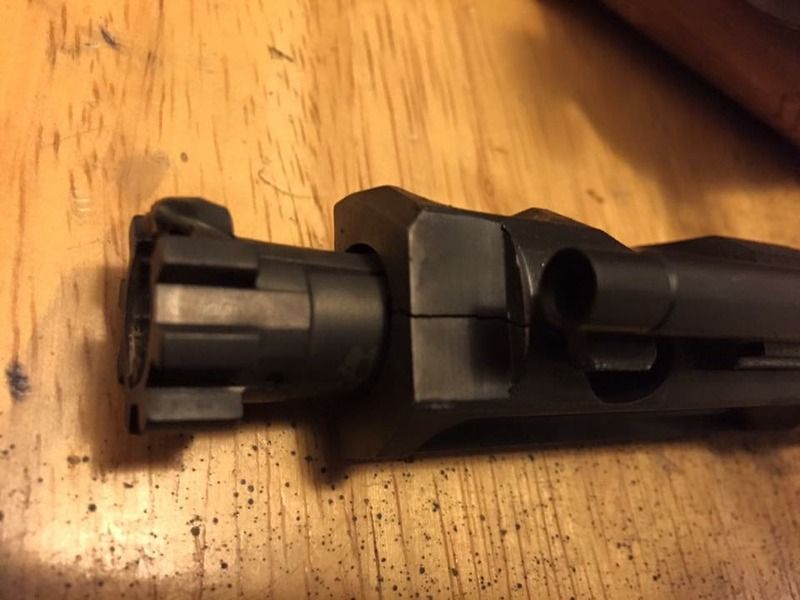 Pic 5 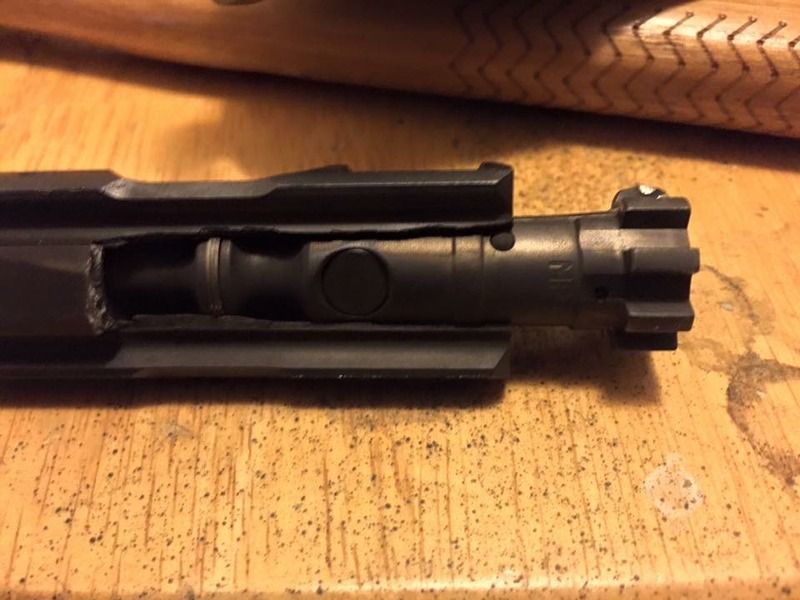 Pic 6 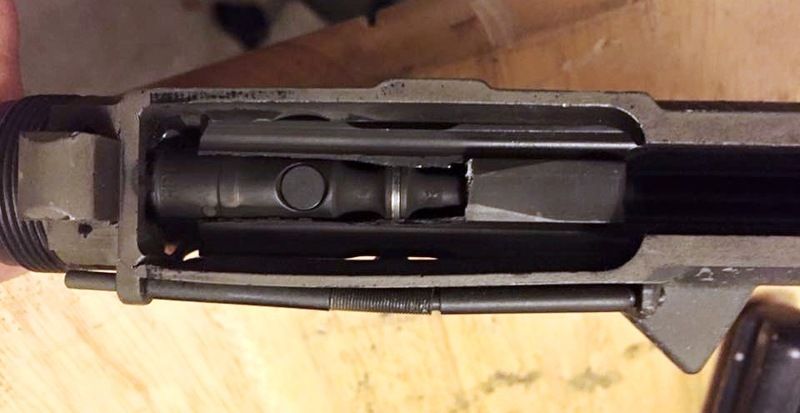 Pic 7 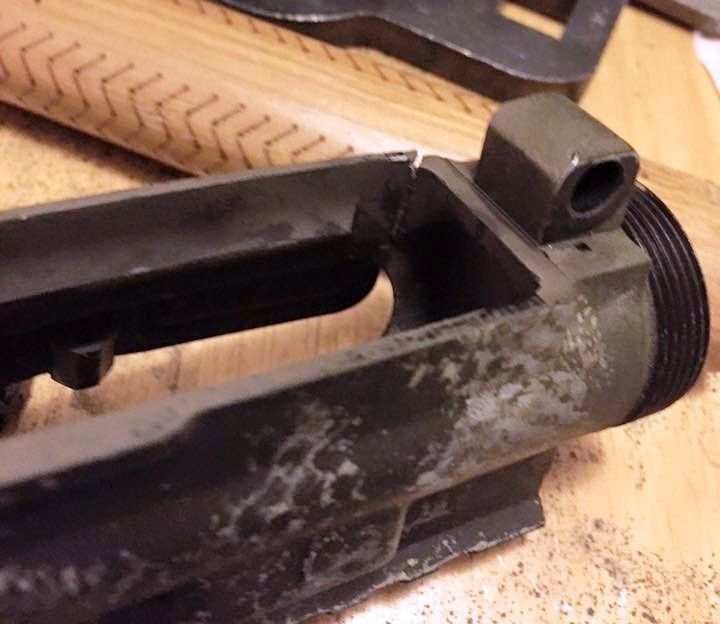 Pic 8  | ||
|
| One of Us |
Obviously tremendous amount of pressure to split the bolt carrier as shown for it is quite a strong set up even though just a 223. Would require lots of questions and examinations of the event and "remains" of the rifle, but from what I see it appears to be caused by barrel blockage. Is there any deformation of the barrel itself such as splitting or bulging? Other possibility is improper powder used for the cartridge, but just one out of 12 makes me question that theory. If were a reload with appropriate powder, it is impossible to put a double charge of powder in that case, but using something akin to Bullseye would do that, but highly unlikely. Would definitely contact the ammo supplier and give them lot no. of the loads. Other possibility would be a larger load than a safe load, but highly compressed and cause a spike in pressure, but I question that as well. An extremely light load can cause detonation and spike in pressure as well. All of the above is simply a guess on my part but have seen such destruction before on 15's and other firearms, but those were due to barrel obstructions. Am sure others will have ideas to what caused the failure, but hopefully the shooter is OK. | |||
|
| one of us |
Am told no bulge in barrel or damage from the chamber forward. All the lugs/lock up appears intact (from the photos, I've not seen the rifle remains). Just for the sake of discussion, lets assume the powder charge/pressure was okay (~50,000psi) and it wasn't a barrel obstruction...Could a case head failure - case separation cause this if the bolt lug lock-up was normal? Or question #2 would be could this damage have been cause by the the cartridge firing with the bolt lug lock-up not completed? Say by carbon build up or firing pin protruding forward? My son thinks the dent in the cartridge head by the ejector indicates the cartridge head was moving backwards violently because the bolt wasn't locked up proper when detonation occurred. | |||
|
| One of Us |
My guess is a overload or a bore obstruction. If it was out of battery the casehead would not have stayed in the chamber. | |||
|
| One of Us |
That "dent" is actually where the brass is extruded into the ejector hole, which is a sign of extreme pressure. | |||
|
| one of us |
If it was indeed a massive over-pressure load then I give credit to the primer for withstanding the pressure. | |||
|
| One of Us |
I noticed that your bolt is marked MPI for magnetic particle inspected. Many aftermarket bolts do not have this done as a cost savings, but I make sure all my bolts come from a known source that MPI's them and marks them as such. Just more insurance in a case like this. If there was a bore obstruction, it should be readily visible in the bore as a ring. It could well have been an out of battery incident, the case failed at the least supported area of the bolt. DRSS(We Band of Bubba's Div.) N.R.A (Life) T.S.R.A (Life) D.S.C. | |||
|
| One of Us |
Could not tell from the pics- by chance is the case in question a Federal (marked FC or Federal) There is a well known problem with some FC brass-very soft in the head/web, and many documented kabooms involve them. Note that no one was injured-AR kabooms usually blow downward. | |||
|
| One of Us |
Just to second HPMaster's comment, and if the brass is Federal, at High Power matches you will see some shooters using Federal brass and it is known by more experienced shooters who normally reload to not use that brass for they have soft primer pockets and won't take many loads before scrap. Have read that Federal has improved the brass in that area?? | |||
|
| one of us |
Looks like a bolt out of battery, or a case head failure to me. DOUBLE RIFLE SHOOTERS SOCIETY | |||
|
| One of Us |
Case head failure due to pressure-certainly, out of battery fire? I doubt it, too much case remaining and OOBDs are very rare. Carbon ring in the leade causing over pressure? Possible. Lesson Learned? Always were safety glasses. Always reload your own! (Or never use reloads) | |||
|
| one of us |
Who made the rifle? or put it together | |||
|
| one of us |
I blew up one of the pics and think I can make out WCC on the case head. Had to be a massive over pressure to move brass like that. | |||
|
| One of Us |
Thank you for sharing the pictures. It was not out of battery; you can see the case head was extruded into the bolt face. It was *extreme* pressure. The case head is what finally let go via the extractor cutout in the bolt. If it was commercial ammo, the ammo mfg should replace the gun in my opinion. | |||
|
| One of Us |
Chi-Com crapola got in there somewhere, obviously. All The Best ... | |||
|
| One of Us |
Overpressure ammunition. Case head blew out through Even reputable ammunition manufacturers produce bad ammunition once in a while. Calguns is down right now so I can't link to the thread. But a recent thread there, a reloader used IMR 4227 instead of IMR 4064 in the 223 Tika. The cartridge blew out through the bolt extractor, just as this did. | |||
|
| One of Us |
At what point was the empty brass in the second photo fired? Was there a case on the ground which is missing a neck from being over annealed? A neck which perhaps stayed in the chamber causing the next round to stop short and slam fire? Is that even possible in an AR? | |||
|
| One of Us |
Slamfires occur in the AR15 action, just as in any action with a free floating firing pin and sensitive commercial primers. The original M16 went through a slamfire period. This might be of interest Icord report page 4560 Mr. Stoner. Well, yes, because I knew that the rifle was, you know, was going to be used by the armed service and I wanted to make sure that we had adequate background on it before we went into it. Because the history, and all the testing that was done with the IMR propellants. We had another thing that happened on the Marine Corps test that went with that. We had some inadvertent firings of the weapon due to the primer that we were using. We were using a commercial primer in that round which is relatively soft and sensitive, and the Marines, on their firing, on their known distance range, would single load the weapon. They would put a round in the chamber and then let the bolt go home by pushing the closing button on it or the bolt catch, and the inertia of the firing pin would fire the weapon sometimes this way. It was a very low frequency, but it did happen. So, of course, they wanted something done about it, and the Army found out about this. There were a couple of solutions. Either desensitize the primer, make it out of a thick material, or lighten up the firing pin. Well, what I recommended was lightening up the firing pin because I didn’t see-if you desensitized the primer too much it could cause failures to fire in the field. In other words, we wouldn’t have enough energy to fire the primer under all conditions. And I-in this technical data package they decreased the sensitivity of the primer at the same them they went in and put the ball propellant in. So these were two things I objected to with Mr. Vee. Here again, I didn’t know what the effects would be because we didn’t have all this test data, I mean testing, behind us that we had on the other ammunition. While the design on the firing pin, to lighten it, which was subsequently done by Colt, was a relatively simple thing, and in my opinion, wouldn’t detract from the performance of the weapon any. As I say this weapon was tested for years and years and before this inadvertent firing ever come up and it come up because probably we had a batch of ammunition where the sensitivity level on these primers were on the low end, or, I should say, the high end of sensitivity, and also, the fact that there were firing the weapon in a way that they formerly didn’t before, which was single loading, when it was an automatic weapon. Usually the weapon was loaded from the magazine and when the rounds were stripped out of the magazine like it was intended to be used, this slowed the bolt down enough that you didn’t have the impact velocity to cause an inadvertent firing. There were actually two things that I took exception to on that. I didn’t sit in on the Board that came up with the ammunition specification. I wasn’t asked to. I am not in the ammunition business. But, I have a good deal of interest in the ammunition due to the fact- usually you can’t change the ammunition without causing a change in the performance of the weapon. So Eugene Stoner is blaming the user. Poor user putting a round in the chamber and dropping the bolt, and a slamfire happening. Bad, bad, stupid, stupid user. Of course all the user's fault as the only proper way to load Stoner's rifle is from the magazine. Well it turns out, what Stoner does not know is more interesting. The M16 was developed on a shoe string budget and two things Eugene Stoner did not know, was the kinetic energy of his firing pin and the sensitivity of commercial rifle primers. It turns out, when the Army did the investigation, Stoner's original design, the kinetic energy of the firing pin was always above the "none fire" level for commercial primers. It was only a miracle that more slamfires did not occur. Probably many did, but since the users were firing from the magazine, they may have thought they bumped the trigger. The Army had the resources to analysis the situation. Firstly they measured the kinetic energy of the M16 firing pin, examined the kinetic energy and compared commercial primer sensitivity and came up with a predicted slamfire rate. With the original firing pin and commercial primers, that slamfire rate was way too high. The Army then required a less sensitive primer for their ammunition, the Army calls it a #41 primer. For American's, this is their "mil spec" small rifle primer. Stoner did not specify a primer sensitivity requirement . Stoner was only aware of primer sensitivity from a conceptual basis, he had no idea of what the actual numbers were. So when ordering ammunition, Stoner let the ammunition manufacturers decide what primer to use, and at the time all the commercial small rifle primers on the market were sensitive commercial primers. Then the Army required a lighter firing pin to reduce the kinetic impact energy from the firing pin during bolt closure. The slamfire rate in military M16's went down after that. However, commercial 223 ammunition is loaded with whatever primer the manufacturer wants to use, so the in battery slamfire incident report for civilian owned AR15's is quite high. But, slamfires in AR15's are usually in battery. I have heard of credible out of battery slamfires, about two, but compared to the numerous more Garand/M1a out of battery slamfire repports, this is miniscule. Unlike the Garand mechanism, the AR15 positively keeps the firing pin retracted until cam down. Therefore, it is pretty hard to have incidental firing pin contact with the primer prior to cam down. Also, with an out of battery slamfire, case rupture is further up the body. An in battery slamfire in an AR15 nothing bad happens to the case as the lugs are in battery and the intact case gets ejected. So, I don't believe the OP's problem is due to sensitive primers causing a slamfire. I believe this is an overpressure situation. What caused that, I don't know. But, it is very, very rare for an out of battery slamfire to occur in an | |||
|
| One of Us |
A 300 Blackout cartridge will chamber and fire in a 223 Rem/5.56 NATO chamber with similar results. I have saw it happen to a FN SCAR. A 0.308, 220 gr. SMK went through the 5.56 bore. It cost $1200 to bring that rifle back to life. DR #2276, P-100 2021 | |||
|
| One of Us |
Just curious, how many "slam fires" have any of us actually observed first hand with an AR (mil or commercial)? I have been around the AR family for about 30 years and personally fired 10s of Ks of rounds, mil, comm and hand load and have personally seem zero slam fires, and three ruptured heads (all hand loads), none with any of my own weapons/ammo. | |||
|
| Moderator |
This picture is worth 1000 words:  As mentioned,see how flattened the primer is, and how it has even flowed back a little. As also mentioned you can see where the brass has flowed into the ejector hole. for every hour in front of the computer you should have 3 hours outside | |||
|
| One of Us |
I have fired over 18,000 rounds in service rifle competition with the AR15 and have not had or seen a slam fire occur. I experienced one slam fire with my M1 rifle. I clean the primer pockets of all my M1 brass. I do not clean the primer pockets of my 223/5.56 brass. DR #2276, P-100 2021 | |||
|
| One of Us |
I had one during the standing slow fire stage. I dropped a round loaded with the new brass colored WSR, dropped the bolt, and the round went off taking a divot out of the group about 20 feet from the firing line. My scorer laughed at me, and when his turn to shoot came up, either the first or second shot, his AR15 slamfired into the ground. He was using Federal match primers. Bud has at least one President's 100 patch, maybe two, he is a very experienced shooter. Not too long ago I asked him if he had another slamfire and he said yes. He had, with Federal primers, and he stopped using them. Both of us lower the bolt on a round in the chamber. I will put a round in the chamber, point the muzzle down, hit the bolt release with the left hand and guide the bolt down half way with the right. I also shoot my sighting shots from the magazine. At 600 yards, I have to toss a round in the chamber and hit the bolt release but at least the muzzle is aiming level so any slamfires won't go into the dirt near the firing line. A bud of mine came close to being shot at Camp Perry because of a slamfire in the standing stage. A Junior next to him "was handling his rifle dangerously". I think the kid was loading his rifle roughly parallel to the line. I saw this with another competitor, the guy raised his rifle up to his face, barrel parallel with the line, and closed the bolt in this position. I think he was doing this to see that the round did not come out. Any way the kid closed his bolt, his AR discharged, and the round passed in the air space between my Bud's arm and body, as he aimed his rifle standing. Now if you have been around for 30 years, do you remember when you used to be able to load the rifle on the shooting stool? Back in the day I put my M1a on the shooting stool, muzzle up, pressed rounds into the magazine, and tripped the bolt release. No slamfires with the muzzle up. But when the AR's came around, I saw shooters putting the muzzle of their AR on their shooting stools, drop a round in the chamber, and trip the bolt. Enough rifles slamfired through the shooting stool that the rule was changed that you can't load resting the rifle on the shooting stool. I know no one will do this, especially a skeptic, but just Google AR15 slam fire. https://www.google.com/?gws_rd...5+slam+fire&start=10 Lots of slamfire reports in AR15's. | |||
|
| One of Us |
Slamfire, I am not skeptic, just not a witness- 24 years on the Army firing lines, dozens more in HP, tactical training etc, nary a slamfre- Must be the company I keep. I even tried to induce a SF in my AR ( as part of an endurance test protocol)- high primers, fouled FPs, cruddy chambers- no joy in inducing a SF. As an M1 shooter as well, I insure my primers are below deck so to speak, cleaned/uniformed pockets and properly seated primers, and as lefty, I am keen to beware for my face is closer to the exposed chamber than a RH shooter. | |||
|
| One of Us |
Most of what you learned about slamfires was an intentional lie, lies which are to misdirect shooters from the primary cause of slamfires: sensitive primers being whacked by a free floating firing pin. Back in the late 50's, Shooters could buy a NM Garand if they attended Camp Perry. Once these rifles were in the hands of civilians, who used the sensitive commercial primers of the day, slamfires occurred. Also, the M14 was under attack by the Colt M16 advocates. The combination of these things created a dis information campaign by the Army of which, two items became dogma within the shooting community. These were that only high primers and worn out receiver bridges cause slamfires. The concept of primer sensitivity did not exist. By omission, we were taught that slamfires have nothing to do with primers or firearms design. It was understood that slamfires are only caused by shooter misconduct: sloppy ammunition or worn out guns. This is what competitive shooters were taught, this is what the shooting community was taught. None of this is true. It turns out that high primers are the most common cause of misfires. I cite as a reference this document written by a CCI employee: Mysteries And Misconceptions Of The All-Important Primer http://www.shootingtimes.com/2..._st_mamotaip_200909/ If you read this document it turns out for a primer to ignite, the anvil must be firmly seated and the gap between primer cake/cup/anvil must be set. If the anvil is dangling in the air, then a misfire will happen. If the "bridge distance" is incorrect, that is the gap between primer cake/cup/anvil is too large, because the anvil has not been shoved into the cake, then a misfire will occur. Something else we were taught, by omission, was that there is no such thing as primer sensitivity. A primer is a primer is a primer. That was a lie. Primer sensitivity varies for primers, it varies by design, and it varies within the lot. PATR 2700, Encyclopedia of Explosives, gives this information into the design of primers:
It turns out for the Garand/M14 mechanism, the US military specified an insensitive primer, the #34 primer. It has a specific priming compound composition: FA 956 Lead Styphanate 37.7 +/- 5% Tetracene 4.0 +/- 1% Barium Nitrate 32.0 +/- 5% Antimony Sulfide 15.0 +/- 2% Aluminum Powder 7.0 +/- 1% PETN 5.0 +/- 1% Gum Arabic 0.2%  I met Soldiers who shot on rifle teams of the late 1950's and 1960's. These guys never saw or heard of a slamfire. They were also issued military ammunition which was tailored to the characteristics of the weapons they were using. One ex Soldier, he had seen literally tens of thousands, perhaps hundreds of thousands of rounds go downrange, at ranges and in Vietnam. Never a slamfire. Then, around 2010, this bud of mine was single loading a Lackland AF NM 308 Garand with LC 308. He put a round in the chamber, dropped the bolt, and the rifle slamfired in battery. That shook him up. I discussed slamfires with an AMU National Champion I occasionally meet at rifle matches. This gentleman won Service Rifle at Camp Perry prior to 1995, when the M14/M1a ruled. He saw lots of slamfires, and out of battery slamfires. He did not bother to investigate the causes, but I will bet the primary reason was Federal Match primers. Which are the most slamfiring primer on the market. The receiver bridge was and always was, a firing pin retraction bridge. I am of the opinion that calling it a "safety" bridge is a creation from the early 60's. It is not a positive firing pin block, nor was it ever meant to be. I examined John Garand's' patent, the functions of the firing pin tang and the firing pin retraction bridge are explicitly spelled out and not as a firing pin block. Its primary function is to retract the firing pin at unlock. There is a slot allowing the firing pin to go forward when the bolt is in battery, but the function of the whole as a firing pin block is not claimed. The extractor is claimed as a means of holding the firing pin. Patent 1 892 141 Semi Automatic Rifle. J. C. Garand Dec 27 1932 The firing pin is formed at its rear end with a laterally extending had 72 adapted to contact a projection 73 formed in the receiver when the bolt is in unlocked position so that the firing point is retracted into the bolt, but the head is cut away at 74 to pass such projection when the bolt is locked to permit the pin to be moved to its extreme forward or firing position. "I claim": 5. The combination with a gun provided with a receiver, of a bolt receiprocable in the receiver, a firing pin reciprocal in the bolt, a laterally extending head for the pin and means in the receiver to engage the head on rocking of the bolt to unlocked position to retract the pin 6. The combination with a gun provided with a receiver, of a bolt reciprocable in the receiver, a firing pin in the bolt, an extractor carried by the bolt, and means on the extractor to prevent rotation of the pin with respect to the bolt. 7. The combination with a gun provided with a receiver, of a bolt reciprocable in the receiver, a firing pin in the bolt, an extractor carried by the bolt, and means on the extractor cooperating with the pin to limit movement thereof. 8 The combination with a gun provided with a receiver, of a bolt reciprocable in the receiver, a firing pin in the bolt, an extractor carried by the bolt, and means on the extractor to limit reciprocatory movement of the pin with respect to the bolt and prevent rotary movement thereof with respect thereto. If John Garand could have claimed the receiver bridge as a firing pin block, he would of claimed it in his patent. The Garand mechanism controls slamfire rates by primer insensitivity. I reduce the probability of slamfires in these mechanisms through several practices. Firstly I full length resize and I use a small base die. I want the case smaller than the chamber. Neck sizing or partial neck sizing is positively dangerous in this mechanism. If the bolt has to stop, to crunch fit the case to the chamber, that firing pin is rebounding off the primer when the bolt lugs are out of battery. The combination of oversized cases and sensitive primers is the most common cause of out of battery slamfires in this mechanism. I do ream primer pockets to depth as I do not want anything but the firing pin to make contact with a seated primer. I also use the least sensitive primers on the market, which are CCI #34's and the Tula mil spec primers. I sent my match Garand over to Roland Beaver for installation of one of his firing pin springs. This spring reduces the impact energy of the firing pin, which should reduce the probability of a slamfire. 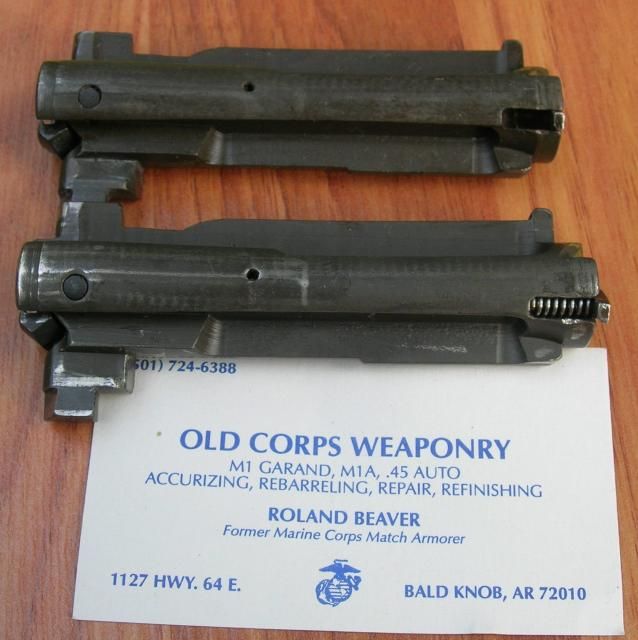 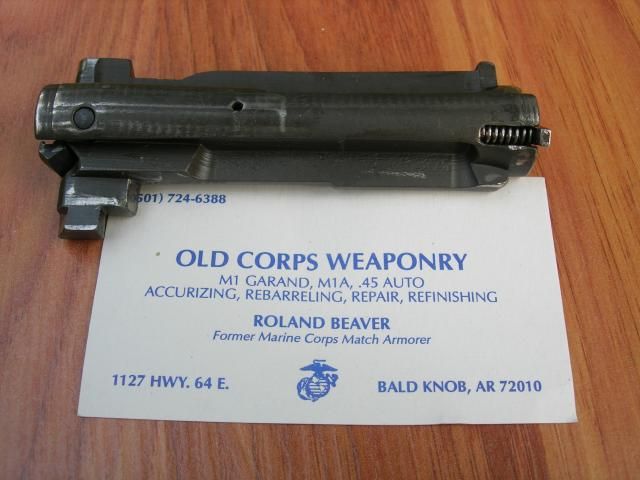 Roland charged me $25.00 total, I shipped it on a Monday, received the bolt back next Monday. It is not a 100% cure, as the firing pin will still make incidental contact with the primer. These are two cases, which I loaded into the chamber, dropped the bolt, muzzle pointing down, and even with the Roland Beaver spring, the firing pin dimpled the primers. 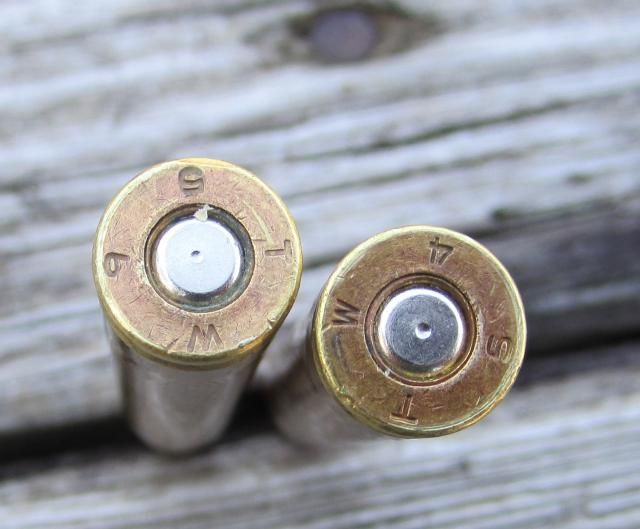 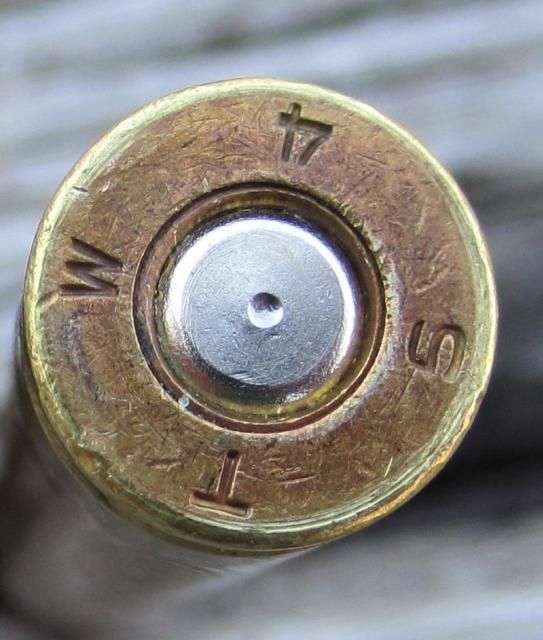 It is amazing that for decades, shooters had been seeing these dimples on ammunition chambered in Garands, M1a's, M1 carbines, mini 14's, and discounting the idea that this might be the reason they were having slamfires. But, they did. It shows how susceptible people are to the teachings of Authority, in this case, the Army and the National Rifle Association. If authority creates a dogma, teaches it as truth, people will discount the very evidence before their eyes, that shows what they have been taught, is wrong. | |||
|
| One of Us |
SLamfire; We do not disagree on any of the root causes of slamfires- I agree with everything you document regarding why SFs occur-I just have not observed a slamfire as stated. Case head failures, sure, on occasion, but nary a SF/OOBF. I believe that with an M1, a SF/OOBF could be induced with high seated primers/fouled pockets, but as you state and document, anvils must be seated to ignite the mix, so a high but not properly seated primer ( clean pocket) likely would not produce a SF. My Dad, now passed, recounted a story of an M1 going full auto when hammer or sear hooks failed, which basically means the FP was forward due to hammer following the bolt, but that is not in the same category as a primer induced Sf- He indicated that all shots were fired from the clip and the gun no worse for wear OT than the trigger group parts which failed, so these rounds must have been in battery slam fires- a big difference from OOB SFs. It seems an OOB SF is primer induced all if not most of the time it can be investigated. Again, in mil spec or run of the mill commercial ARs, never seen a SF (plenty of negligent discharges, though, thankfully with not or minor adverse impacts). In my AR rifles, I use Tula KVB 556s ( hard cup mag supposedly)which actually provide more consistent stats over the chrono than 7.5s or Fed GMs, or CCI 450s and an occasional 41; in my M1, I use Win LRs or CCI 200s, whichever I have at hand. I never used a SB die for match ammo (combat/SD ammo is factory fodder)- but FL and pocket clean every time, as well as insure trim length does not exceed 2.494 in the 06 or 1.760 in the 223/556-even though I know the chamber length to throat is longer, much longer. Shoulder bump back .003-.004 for case life and minimal cartridge slop-for accuracy/match loads. Best; | |||
|
| One of Us |
With mechanical failures anything bad can happen. Here is a link to a UTube video where an ejection seat malfuncted, ejecting the navigator: Partial Ejection from A-6 Aircraft https://www.youtube.com/watch?v=Z6DQEPIWLFc These are links to the story of a British Pilot whose ejection seat fired when it was not supposed, and he died. http://www.bbc.com/news/uk-eng...incolnshire-25943211 http://www.telegraph.co.uk/new...th-says-coroner.html I am certain no one expected or predicted these mechanical malfunctions, and when they occurred, they were not subtle. Luckily, in the Garand design, the receiver bridge does serve a safety function. The hammer nose engages a recess under the bolt and cams the bolt shut. The hammer cannot touch the firing pin until the bolt lugs are in battery. So this is all to the good. 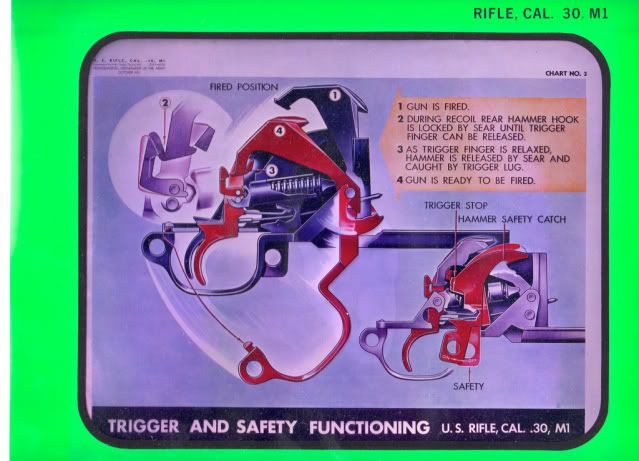 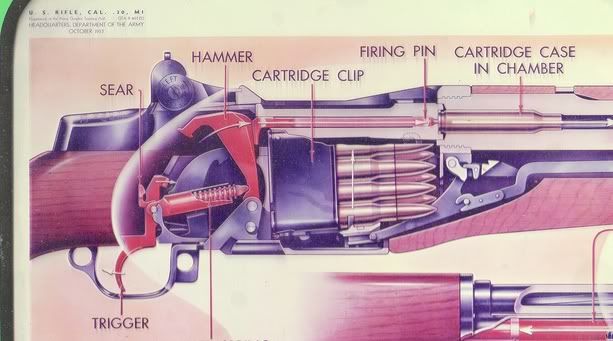 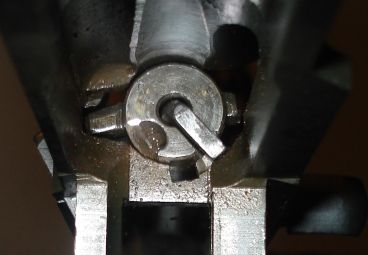 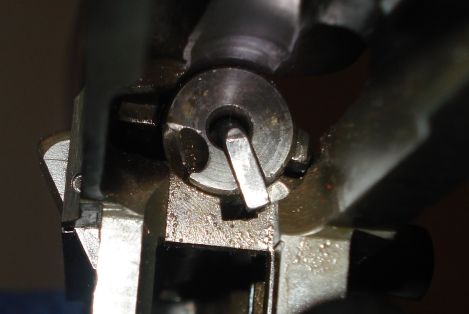 That pencil mark is the point in bolt rotation when the firing pin clears the receiver bridge channel before lugs are fully engaged. It is possible to have too much headspace, and thus a blown case head at this point, and damage to either the bolt or receiver. Neither of which I have ever seen in "following incidents". 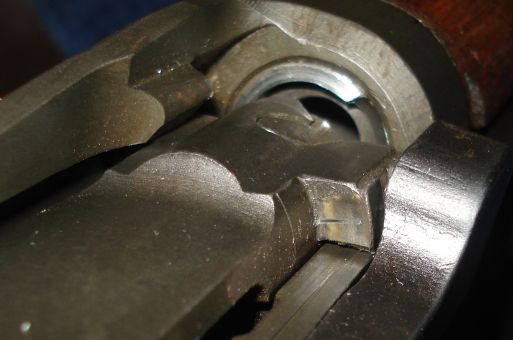 I have been shooting Highpower for more than a couple of decades and I have been drafted mnay times to run the line. There have been a number of occasions when someone's trigger job failed. The hammer hooks had been stoned too much, the hammer "followed" the bolt home, the M1a went chug, chug, usually doubling, during a rapid fire sequence. Because of the safety features in the action the action was always undamaged. Because we are nice guys, we would let the shooter go again in an alibi relay, and always, the gun would "follow" again, there was no dispute about mechanical safety and the gun would be withdrawn from the line. Slamfires due to mechanical failure are not subtle and do not go away. However, primer initiated slamfires are subtle. People often think they bumped the trigger. When they are out of battery, failure can be catastrophic to the mechanism. I have a paper copy of this Army report. USATECOM Project No 8F-3002-04, Comparison Test of rifles, 7.62 MM, M14 Manufactured by Springfield Armory and Harrington and Richardson Arms Company. Author G. E. Hendricks, July 1963. The Army was testing production models of H&R’s and SA’s for dimensional part compliance, (part interchangeability), such things as the thickness of the chrome coatings were measures, rifles were reassembled after gaging and underwent endurance testing. At round 5271 a Springfield Armory M14 went off out of battery, with military ammunition. The report states: “One rifle fired when the bolt was in the unlocked position causing breakage for the firing pin, extractor, bolt roller, ejector, and stock. The magazine split, causing the magazine floor-plate spring and 12 rounds of ammunition to be ejected against the bench rest from which the rifle was being fired. The case ruptured and several pieces of brass were found in the area. A broken part of piece of brass perforated a cardboard box with was position between the gunner and the proof director. The cardboard box was used as a brass catcher. Not all the broken pieces were found. Although no one was physically injured this is a seriously unsafe condition.” So, six rifles were tested, five completed the test firing 6000 rounds each, one slamfired out of battery at round 5271, for a total round count of 35, 271. Therefore the probability of an out of battery slamfire with mil spec primers is 1:35,000. I am mad at those who knew of the propensity of the Garand action to slamfire, knew the causes, and lied about high primers and worn out receiver bridges. If they had simply told the truth, I would not have been using Federal Match primers, would have small based everything, and would not have had two out of battery slamfires in the things. These guys, knew far more than anything I have been able to find. The last, the "Prime Davidian" wrote a Dope Bag article in the American Rifleman stating that only high primers and your worn out receiver bridge cause slamfires. Lies like that hurt people by not giving them the full information to protect themselves. I ran into a number of happy idiots who were proud to tell me they neck sized their long range ammunition. From the best information sources and authorities available, this was a safe practice. After all, conventional wisdom was that only high primers and worn out receiver bridges cause slamfires. This conventional wisdom was based on Army accounts and NRA accounts. But, what they were doing had the highest probability of creating an out of battery slamfire in one of these mechanisms. | |||
|
| One of Us |
Have shot Garands, M14, and AR's for lots of years and pretty much understood by all with experience of those rifles to not put round in chamber unless being stripped from magazine by bolt. Reason simply that effort/energy required of bolt moving forward and stripping round from magazine will not provide enough strike force of the floating firing pin to strike the primer sufficiently to ignite it. In some 50 yrs. have never experienced a SF, but did witness one several years ago, but from time to time the rifles would "double." Almost always occurred when the shooter decided he was going to make his trigger equal to a Jewell on a bolt match rifle. Very shallow gene pool. | |||
|
| One of Us |
Junk in the trunk. Get rid of it. All The Best ... | |||
|
| one of us |
I wonder why Matt hasn't gotten back to us about who built the rifle or put it together. Lots of speculation going on but personally I bet it was a rifle problem not a ammo one. | |||
|
| one of us |
Look closely at the primer... Look at how much damage there is to the rear of the case... Looks like out of battery incident to me. Seen it a few times with reloads, in the AR. I HAVE seen several hundreds of thousands of rounds fired in AR's, NEVER seen a slam fire in one. Have seen a few in a Garand, with reloads. DOUBLE RIFLE SHOOTERS SOCIETY | |||
|
| One of Us |
Chi-Com crap ammo. All The Best ... | |||
|
| one of us |
Reason I haven't got back is because I don't know a lot of the details; who built it, what parts, what ammo. My son sent me the photos...rifle belonged to an acquaintance of his. What you see is what I know and am not in a position to turn this into an inquisition. Obviously the owner of the rifle isn't too happy. | |||
|
| Moderator |
Could it be 300 blackout in a 556 chamber ? #dumptrump opinions vary band of bubbas and STC hunting Club Information on Ammoguide about the416AR, 458AR, 470AR, 500AR What is an AR round? Case Drawings 416-458-470AR and 500AR. 476AR, http://www.weaponsmith.com | |||
|
| One of Us |
Looks like maybe brass separation or bad load. Looks like loaded with C4. Glad no one was hurt.JP | |||
|
| Powered by Social Strata |
| Please Wait. Your request is being processed... |
|
 The Accurate Reloading Forums
The Accurate Reloading Forums  THE ACCURATE RELOADING.COM FORUMS
THE ACCURATE RELOADING.COM FORUMS  Rifles
Rifles  Modern Military Rifles
Modern Military Rifles  AR blow up- what happened?
AR blow up- what happened?

Visit our on-line store for AR Memorabilia

